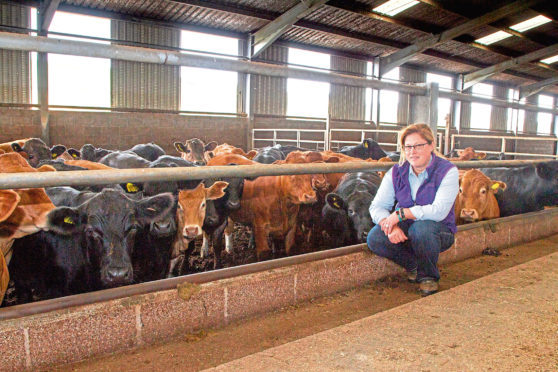Beef farmers will soon be able to fine-tune their breeding programmes to select animals that grow more from eating less.
Natalie Cormack from farm levy body AHDB said an innovative UK-wide project will eventually lead to the development of breeding values for feed intake, which will in turn lead to farmers selecting more efficient animals.
The Beef Feed Efficiency Programme – which involves four farms across the UK, including one in Scotland – involves monitoring individual daily feed intake in beef cattle using state-of-the-art equipment.
The Scottish leg of the project, which takes place at Ingliston Farm at Eassie, Forfar, has been funded by the Scottish Government and meat processor ABP.
It is managed by Scotland’s Rural College, SRUC, and AHDB. Across the rest of the UK the project is funded by Defra and AHDB.
Ms Cormack said Ingliston Farm is just finishing its fourth batch of cattle in the project.
All cattle, which are either sired by Limousin or Aberdeen-Angus bulls, are bought in as stores from across the country.
They then embark on a 91-day trial, which involves 28 days of acclimatisation and 63 days –nine weeks – of data measuring.
“They are all fed on the same diet,” said Ms Cormack.
“It’s a forage-based diet, with forage making up about 75% of the diet.
“And all of the four units (in the project) are kept on the same feed specification.”
She said electronic identification (EID) enables researchers to collect accurate data throughout the trial, and the cattle are bedded on sawdust to prevent them eating any straw.
Special feed troughs, featuring EID sensors and weigh-scales, enable measurements to be taken on the amount each individual animals eats throughout the day.
They are also taken through an automatic weigh-scale once a week and scanned twice – once at the beginning of the trial and then again at the end – for muscle depth and fat cover. DNA samples are also taken.
“What we are measuring is the feed intake so that we can actively select for animals that eat less (and grow the same),” said Ms Cormack.
“Most of the cattle in the trial are Limousin crosses. We started with the Limousin breed because it’s numerically the biggest in the UK.
“And with the introduction of this Scottish unit and extra funding, we have been able to bring forward the introduction of a second breed.
“That’s the Aberdeen-Angus because it’s the biggest of the native breeds numerically.”
She said data collected from the project would lead to the development of estimated breeding values to help farmers select animals with better feed efficiency.
The British Limousin Cattle Society hopes to have this established by February 2019 for the spring bull sales.
“The aim is to select cattle that eat less and grow the same,” said Ms Cormack.
“We can work all the information back to the sire and plot daily liveweight gain against feed intake.
“This is the first opportunity we have had in the UK to monitor individual feed intake. It’s not an inexpensive exercise.”
Project host farmer, Alec Mitchell, said: “I think this project will put the beef industry in the right direction but it will take a while to see the results.”
Professor Eileen Wall from SRUC, who leads the project in Scotland, said: “A number of other countries have already made movements in this area and it’s important for the Scotch Beef brand to maintain its international reputation.
“It’s also extremely good for the environment as producing the same amount of beef with less feed means fewer methane emissions per kilo.”
In fact SRUC estimates that selecting more efficient cattle could result in a 22% reduction in on-farm greenhouse gas emissions and a 39% boost in profitability.
SRUC’s Professor Mike Coffey said: “The efficiency with which farmers use resources to produce food will come under increasing scrutiny from consumers and government. This is a proactive move by the industry to select animals that are more efficient converters.”
ABP’s general manager in Perth, Frank Ross, said: “ABP has a very strong interest in efficient and profitable beef production to ensure a high throughput of home-grown beef through its state-of-the-art processing plants.”
